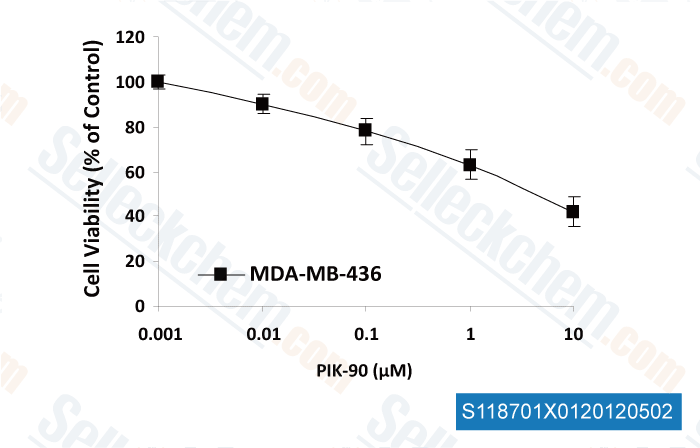|
Toll Free: (877) 796-6397 -- USA and Canada only -- |
Fax: +1-832-582-8590 Orders: +1-832-582-8158 |
Tech Support: +1-832-582-8158 Ext:3 Please provide your Order Number in the email. |
Technical Data
| Formula | C18H17N5O3 |
||||||
| Molecular Weight | 351.36 | CAS No. | 677338-12-4 | ||||
| Solubility (25°C)* | In vitro | DMSO | 2 mg/mL (5.69 mM) | ||||
| Water | Insoluble | ||||||
| Ethanol | Insoluble | ||||||
| In vivo (Add solvents to the product individually and in order) |
|
||||||
|
* <1 mg/ml means slightly soluble or insoluble. * Please note that Selleck tests the solubility of all compounds in-house, and the actual solubility may differ slightly from published values. This is normal and is due to slight batch-to-batch variations. * Room temperature shipping (Stability testing shows this product can be shipped without any cooling measures.) |
|||||||
Preparing Stock Solutions
Biological Activity
| Description | PIK-90 is a PI3Kα/γ/δ inhibitor with IC50 of 11 nM/18 nM/58 nM, respectively, less potent to PI3Kβ. | ||||||||
|---|---|---|---|---|---|---|---|---|---|
| Targets |
|
||||||||
| In vitro | PIK-90 shows distinct patterns of isoform selectivity to inhibit different subsets of four class I PI3K isoforms. In addition, this compound completely inhibits the fMLP-stimulated phosphorylation of Akt and impairs polarity and chemotaxis in dHL60 cells. [1] It exhibits significantly antiproliferative activity by effectively blocking phosphorylation of Akt in six glioma cell lines varying in mutational status at PTEN or p53, including U87 MG, SF188, SF763, LN229, A1207 and LN-Z30 cells. Moreover, this chemical induces a modest G0G1 arrest at a concentration (0.5 μM) sufficient to inhibit phosphorylation of Akt substantially. [2] In chronic lymphocytic leukemia (CLL) cells, it inhibits chemotaxis to levels that are 57.8% of controls at 1 μM and 56.8% of controls at 10 μM. Consistently, this inhibitor inhibits pseudoemperipolesis to levels that are 74.2% of controls at 1 μM and 57.9% of controls at 10 μM. In addition, it also leads to a significant reduction of CLL cell migration into the stromal cell layer and decreases CXCL12-induced actin polymerization. [3] | ||||||||
| In vivo | Immediately following insulin treatment, PIK-90 (10 mg/kg) completely protects animals from this insulin-stimulated decline in blood glucose. [4] |
Protocol (from reference)
| Kinase Assay:[1] |
|
|---|---|
| Cell Assay:[2] |
|
| Animal Study:[4] |
|
References
|
Customer Product Validation

-
Data from [ J Biol Chem , 2014 , 289(18), 12467-84 ]

-
Data from [ J Cell Biol , 2012 , 198(2), 185-94 ]

-
, , Dr. Yong-Weon Yi from Georgetown University Medical Center

-
, , Saraswati Sukumar of Johns Hopkins University School of Medicine
Selleck's PIK-90 Has Been Cited by 31 Publications
| Enhancer remodeling by OTX2 directs specification and patterning of mammalian definitive endoderm [ Dev Cell, 2025, S1534-5807(25)00496-4] | PubMed: 40834858 |
| Reciprocal regulation of MMP-28 and EGFR is required for sustaining proliferative signaling in PDAC [ J Exp Clin Cancer Res, 2025, 44(1):68] | PubMed: 39994761 |
| Generation and characterization of induced pluripotent stem cells of small apes [ Front Cell Dev Biol, 2025, 13:1536947] | PubMed: 40177132 |
| Efficient generation of human NOTCH ligand-expressing haemogenic endothelial cells as infrastructure for in vitro haematopoiesis and lymphopoiesis [ Nat Commun, 2024, 15(1):7698] | PubMed: 39227582 |
| A secreted proteomic footprint for stem cell pluripotency [ PLoS One, 2024, 19(6):e0299365] | PubMed: 38875182 |
| Directed differentiation of hPSCs through a simplified lateral plate mesoderm protocol for generation of articular cartilage progenitors [ PLoS One, 2023, 18(1):e0280024] | PubMed: 36706111 |
| Lateral plate mesoderm cell-based organoid system for NK cell regeneration from human pluripotent stem cells [ Cell Discov, 2022, 8(1):121] | PubMed: 36344493 |
| Plasma membrane-nucleo-cytoplasmic coordination of a receptor-like cytoplasmic kinase promotes EDS1-dependent plant immunity [ Nat Plants, 2022, 8(7):802-816] | PubMed: 35851623 |
| CK2-induced cooperation of HHEX with the YAP-TEAD4 complex promotes colorectal tumorigenesis [ Nat Commun, 2022, 13(1):4995] | PubMed: 36008411 |
| SARS-CoV-2 ORF10 antagonizes STING-dependent interferon activation and autophagy [ J Med Virol, 2022, 94(11):5174-5188] | PubMed: 35765167 |
RETURN POLICY
Selleck Chemical’s Unconditional Return Policy ensures a smooth online shopping experience for our customers. If you are in any way unsatisfied with your purchase, you may return any item(s) within 7 days of receiving it. In the event of product quality issues, either protocol related or product related problems, you may return any item(s) within 365 days from the original purchase date. Please follow the instructions below when returning products.
SHIPPING AND STORAGE
Selleck products are transported at room temperature. If you receive the product at room temperature, please rest assured, the Selleck Quality Inspection Department has conducted experiments to verify that the normal temperature placement of one month will not affect the biological activity of powder products. After collecting, please store the product according to the requirements described in the datasheet. Most Selleck products are stable under the recommended conditions.
NOT FOR HUMAN, VETERINARY DIAGNOSTIC OR THERAPEUTIC USE.
